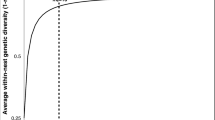Abstract
The optimal timing for initiating reproduction (i.e., the age at first reproduction) is a critical life history trait describing aspects of an individual’s resource-allocation strategy. Recent theoretical and empirical work has demonstrated that this trait is also tied to mating system expression when individuals have the opportunity to reproduce via both self-fertilization and cross-fertilization. A strategy of “delayed selfing” has emerged as a “best of both worlds” arrangement where, in the absence of a mate, an individual will delay reproduction (selfing) to “wait” for a mate. Herein, we extend previously developed predictive optimization models for the timing of reproduction to a situation where organisms can allocate their resources to size-dependent and size-independent defensive strategies to counter the threat of predation. By incorporating inducible defenses into a predictive framework for analyzing life history expression and evolution, we can more accurately evaluate the role that allocation strategy plays in altering the optimal waiting time. We compare our model to previous models and empirical results highlighting that incorporation of inducible defenses into the model broadens the parameter space in which a waiting time is expected and often leads to a predicted waiting time that is longer than in the situation without inducible defenses. In particular, a waiting time is predicted to exist regardless of the strength of inbreeding depression in the population.



Similar content being viewed by others
References
Abrams PA, Rowe L (1996) The effects of predation on the age and size of maturity of prey. Evolution 50:1052–1061
Auld JR (2010) The effects of predation risk on mating system expression in a freshwater snail. Evolution 64:3476–3494
Auld JR, Relyea RA (2008) Are there interactive effects of mate availability and predation risk on life history and defense in a simultaneous hermaphrodite? J Evolut Biol 21:1371–1378
Bell G (1982) The masterpiece of nature: the evolution and genetics of sexuality. University of California Press, California
Charlesworth D, Charlesworth B (1987) Inbreeding depression and its evolutionary consequences. Ann Rev Ecol Syst 18:237–268
Charlesworth D, Willis JH (2009) The genetics of inbreeding depression. Nat Rev Genet 10:783–796
Charnov EL (1982) The theory of sex allocation. Princeton University Press, Princeton
Darwin CR (1876) The effects of cross and self fertilization in the vegetable kingdom. John Murray, London
DeWitt TJ, Scheiner SM (2004) Phenotypic plasticity: functional and conceptual approaches. Oxford University Press, Oxford
Escobar JS, Auld JR, Correa AC, Alonso JM, Bony YK, Koene JM, Pointier J-P, Jarne P, David P (2011) Patterns of mating system evolution in hermaphroditic animals: correlations among selfing rate, inbreeding depression, and the timing of reproduction. Evolution 65:1233–1253
Escobar JS, Epinat G, Sarda V, David P (2007) No correlation between inbreeding depression and delayed selfing in the freshwater snail physa acuta. Evolution 61:2655–2670
Escobar JS, Facon B, Jarne P, Goudet J, David P (2009) Correlated evolution of mating strategy and inbreeding depression within and among populations of the hermaphroditic snail physa acuta. Evolution 63:2790–2804
Fisher RA (1941) Average excess and average effect of a gene substitution. Ann Eugen 11:53–63
Jarne P, Auld JR (2006) Animals mix it up too: the distribution of self-fertilization among hermaphroditic animals. Evolution 60:1816–1824
Lande R, Schemske DW (1985) The evolution of self-fertilization and inbreeding depression in plants i. Genetic models. Evolution 39:24–40
Lloyd DG (1979) Some reproductive factors affecting the selection of self-fertilization in plants. Am Nat 113:67–79
Reznick DN, Bryant MJ, Roff D, Ghalambor CK, Ghalambor DE (2004) Effect of extrinsic mortality on the evolution of senescence in guppies. Nature 431:1095–1099
Reznick DN, Shaw FH, Rodd FH, Shaw RG (1997) Evaluation of the rate of evolution in natural populations of guppies (poecilia reticulata). Science 275:1934–1937
Schärer L (2009) Tests of sex allocation theory in simultaneously hermaphroditic animals. Evolution 63:1377–1405
Scheiner SM (1998) The genetics of phenotypic plasticity. VII. Evolution in a spatially-structured environment. J Evol Biol 11:303–320
Schjørring S (2004) Delayed selfing in relation to the availability of a mating partner in the cestode schistocephalus solidus. Evolution 58:2591–2596
Schultz ST, Willis JH (1995) Individual variation in inbreeding depression: the roles of the inbreeding history and mutation. Genetics 141:1209–1223
Tollrian R, Harvell CD (1999) The ecology and evolution of inducible defenses. Princeton University Press, Princeton
Tsitrone A, Duperron S, David P (2003a) Delayed selfing as an optimal mating strategy in preferentially outcrossing species: theoretical analysis of the optimal age at first reproduction in relation to mate availability. Am Nat 162:318–331
Tsitrone A, Jarne P, David P (2003b) Delayed selfing and resource reallocation in relation to mate availability in the freshwater snail physa acuta. Am Nat 162:474–488
Via S, Gomulkiewicz R, de Jong G, Scheiner SM, Schlichting CD, van Tienderen PH (1995) Adaptive phenotypic plasticity: consensus and controversy. Trends Ecol Evol 10:212–217
Acknowledgements
This work was made possible by a grant from the National Science Foundation to JRA and AK (DEB #1406231).
Author information
Authors and Affiliations
Corresponding author
Rights and permissions
About this article
Cite this article
Stratton, C., Kolpas, A. & Auld, J.R. Optimal Mating Strategies for Preferentially Outcrossing Simultaneous Hermaphrodites in the Presence of Predators. Bull Math Biol 80, 2652–2668 (2018). https://doi.org/10.1007/s11538-018-0481-8
Received:
Accepted:
Published:
Issue Date:
DOI: https://doi.org/10.1007/s11538-018-0481-8




